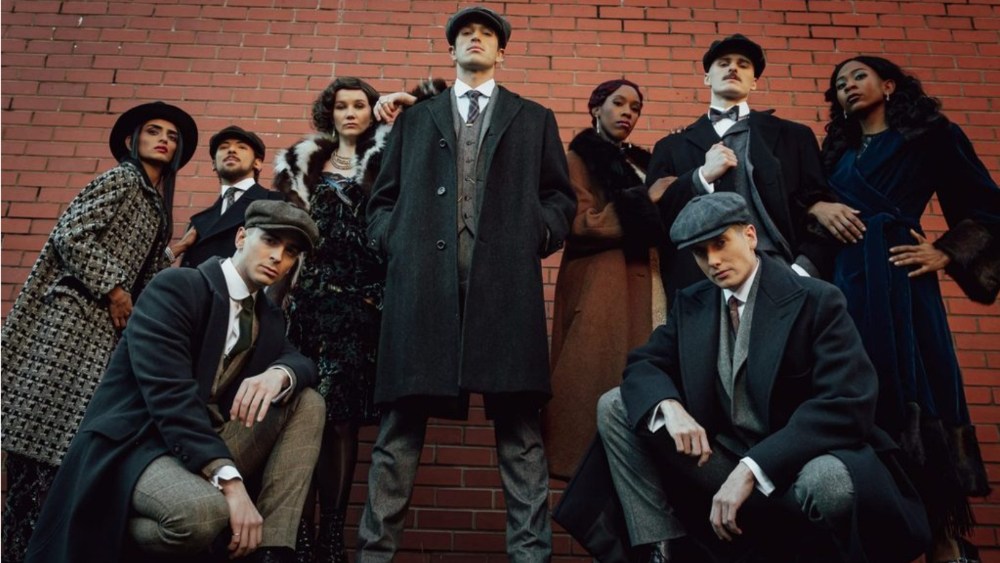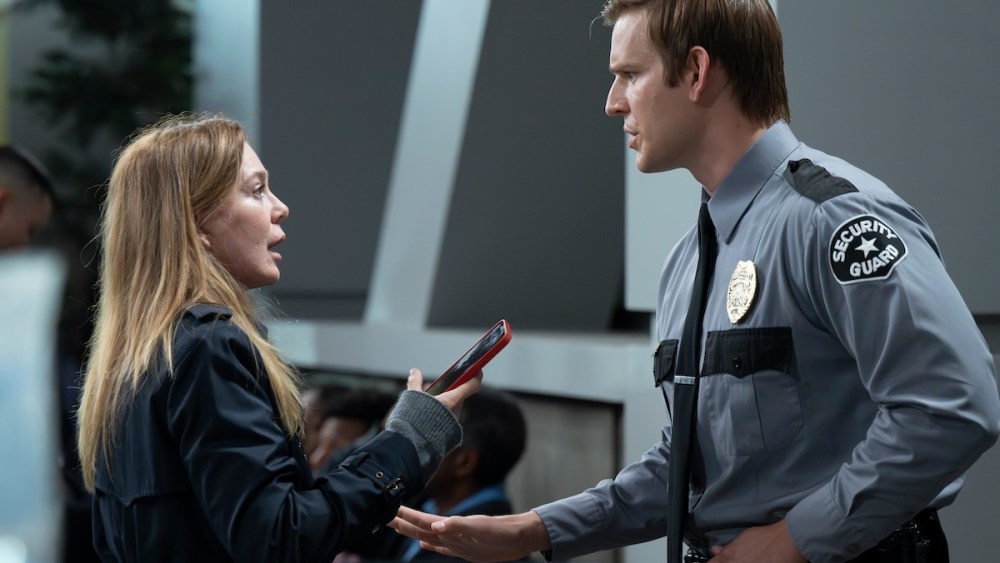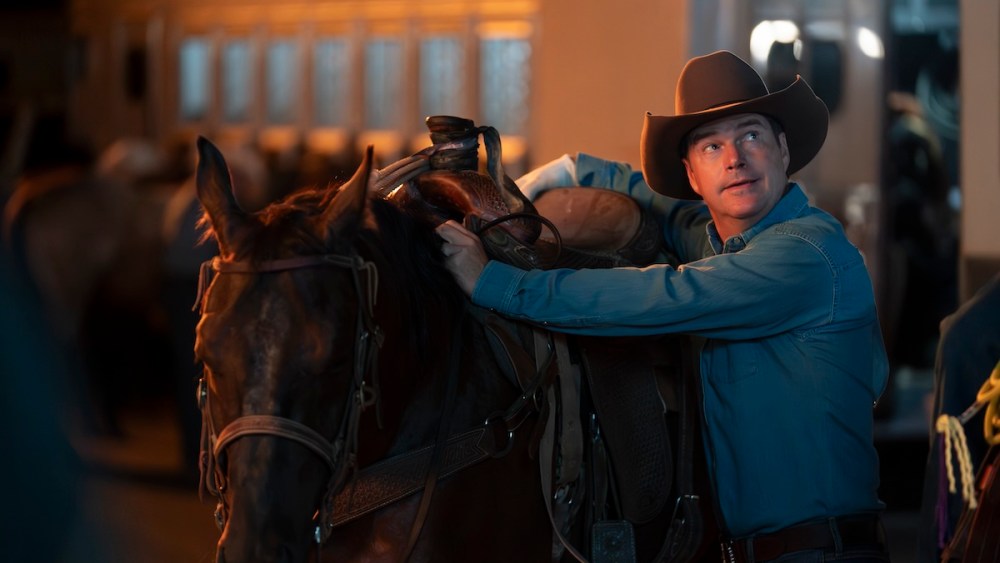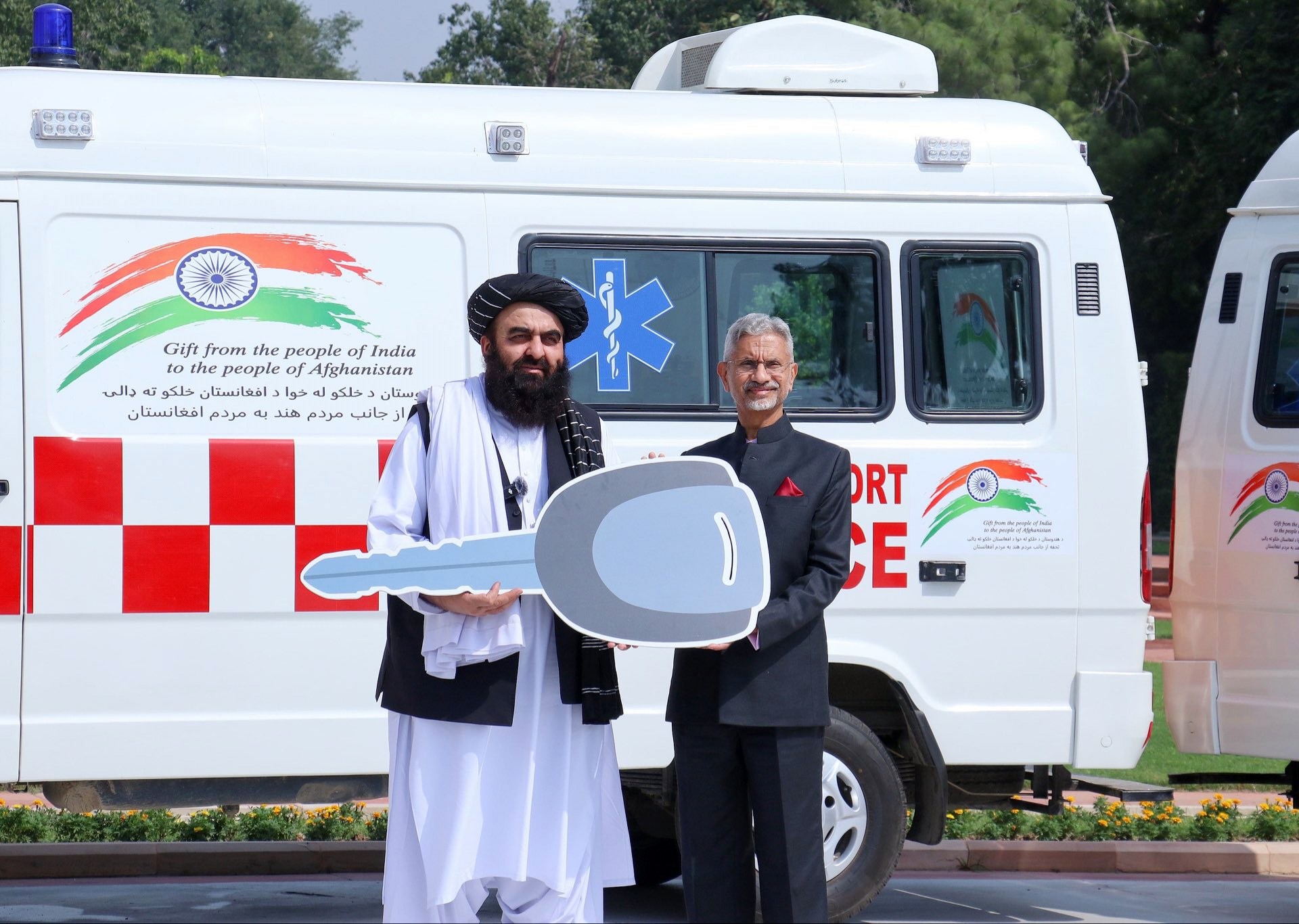Stepping into Dean Devlin’s sun-filled, second-floor office in the West Hollywood headquarters of his company Electric Entertainment on an afternoon in mid-September, the first thing that grabs the attention of a visitor is the friendly, energetic presence of the writer/producer/director/mini-mogul himself — smiling, bespectacled and still-boyish at 63. But then one’s eyes are quickly drawn to a large painting by Richard Sheldon hanging on the back wall over a small couch, next to framed 8-by-10s of Devlin posing with Presidents Clinton and Obama and a photo of a letter from an MCA Universal executive confirming that his father, the late writer-producer Don Devlin, discovered Steven Spielberg (“I always thought he was lying about that,” he says).
The Sheldon painting depicts a young Black man standing on a sidewalk dressed in a baseball cap, jeans and a loose, untucked, long-sleeve, button-down shirt, his arms outstretched, while white people in business attire walk past him in a blur. Its title: “The Invisible Man.”
“I just identified with that so much,” says Devlin.
The guy who co-wrote and produced blockbuster sci-fi adventure movies like “Stargate” (1994) and “Independence Day” (1996) in partnership with director Roland Emmerich while still in his 30s, then broke out on his own with Electric Entertainment to make long-running small screen franchises like “The Librarian” and “Leverage” and yet more movies, from the 2006 documentary “Who Killed the Electric Car?” to his 2017 directorial effort “Geostorm”? You feel like an invisible man?
“Yeah, I’ve always felt that way. For many years, I was Roland Emmerich’s partner, right? He was the big director, and I was writer behind the scenes doing stuff. Also, growing up with a little bit of brown skin,” he says, tapping his forearm with an index finger, “every time you’d walk into a store, someone’s following you around.”

But there’s more evidence in Devlin’s office supporting the idea that, in spite of any bumps, bruises and injustices he’s experienced over the years, he’s led a charmed and fascinating life. Alongside the wall opposite “The Invisible Man” is a photo of his late mother, the strikingly beautiful Filipina actress Pilar Seurat, from her appearance on a 1967 episode of “Star Trek.” (“Scotty kills her,” he points out.) She also appeared in a plethora of other classic TV shows of the era, from “Bonanza” to “Voyage to the Bottom of the Sea.”
“My mom was just always the most supportive person in the entire universe,” says Devlin, whose parents divorced the year after he was born. “I credit her with everything, because when she came home from the set of ‘Star Trek,’ she had one of the stunt guys’ rubber phasers, and she gave it to me. And that was literally the crack that started my addiction.”
If “Star Trek” started Devlin’s addiction, the May 1977 release of “Star Wars” turned him into a hopeless, unrepentant junkie. Fourteen-year-old Devlin rode his bike from his home in the San Fernando Valley over the hill to Hollywood Boulevard and was ninth in line to see the movie on opening day at Grauman’s Chinese Theatre.
“When that first spaceship shot up across the screen, I thought, ‘Oh, that’s cool,’” recounts Devlin. “But when the big one that followed it on screen just kept coming and coming and coming, the audience started screaming and I started screaming. It was literally in that moment that I was like, ‘That’s what I want to do. This is exactly what I want. This experience.’”
The influence of “Star Wars,” which used the latest in visual effects technology to tell an old-fashioned sci-fi adventure story, is obvious in many of his future projects, from “Stargate” on. But he was also drawn to the deeper side of sci-fi.
“’Star Trek’ was always able to talk about things you couldn’t talk about, because you did it in space,” explains Dean. “We didn’t talk about the race relationship, but we had guys who had black face on one side and white face on the other, and they were fighting the guys who had the opposite. With ‘Star Wars,’ I was so thoroughly escaping my reality into this other reality, I got so excited of the idea that we can rewrite the world.”
Devlin’s current career could be regarded as a page-one rewrite. He started out as an actor, doing guest spots on TV series including “Happy Days” and “James at 15” and small roles in the films “Harry and Walter Go to New York” (1976) and “My Bodyguard” (1981), both produced by his father, Don Devlin, who also began his showbiz career as an actor, appearing in films such as “Three Violent People” (1956) and “Blood of Dracula” (1957). But Devlin insists he always viewed acting as a path to a job behind the camera.
“I thought, maybe if I became an actor on a series and the series was successful enough, they’d let me direct some episodes or maybe my acting could get me to where I wanted to go,” he says.
After high school – during which time he participated in biannual drama competitions alongside future stars Jennifer Jason Leigh, Kevin Spacey, Val Kilmer and Mare Winningham – Devlin moved to New York and wound up working as a chauffeur for Al Pacino. One day, the actor caught him sneaking a peak at a script he was considering, titled “Scarface.” He forgave his employee for the transgression and asked him what he thought of it.
“I said, ‘I think you already made this movie. It was called ‘The Godfather’ and was way better than this script.’ Luckily, he didn’t listen to me,” laughs Devlin, who was no stranger to celebrity, having visited Jack Nicholson’s Mulholland Drive home a half dozen times during his youth, thanks to his father’s close friendship with the actor.
Eventually, Devlin left Pacino’s employ to take the lead role in an Off Broadway production of James Kirkwood’s “There Must Be a Pony,” which gave him the confidence to take his acting career seriously. Returning to Los Angeles, he scored a three-episode arc on “L.A. Law” and a co-starring role in the short-lived TV series “Hard Copy” (1986), which led to him being cast in the low-budget sci-fi epic “Moon 44,” helmed by an unheralded German director named Roland Emmerich.
“I didn’t want to do it, but I was desperate for money at that moment, and I was taking care of my mother,” he says. Arriving on the set in Germany, he discovered the director was surprisingly good. “I remember turning to him and saying, ‘My God, you’re a first-rate director, why are you doing this crappy script?’ And he said to me, ‘Well, Dean, when I wrote the script …,’” Devlin laughs.
Devlin asked to rewrite his dialog, which led to him rewriting everyone else’s, too. Emmerich subsequently called on Devlin to do a major rewrite on his next film, the 1992 sci-fi actioner “Universal Soldier,” starring Jean-Claude Van Damme and Dolph Lundgren. Despite bad reviews, the film was a big, franchise-spawning box office success, cementing a filmmaking partnership that would last until 2000.

While Devlin has a deep love (and track record) for sci-fi, it’s not his only artistic passion. By the window in his office, he has two two electric guitars (a Fender Stratocaster and an Airline semi-hollowbody) and a practice amp, which speak to his love of music. Decades ago, he was in a group called Nervous Service and he currently plays in a Beatles cover band with director Rob Minkoff (“Sometimes I’m playing George’s part, sometimes I’m playing John’s part, and I sing Paul’s part,” he explains). Behind his desk is the owl-like helmet worn by the title character in “The Phantom of the Paradise,” Brian DePalma’s 1974 film about a talented but naïve composer who’s swindled and framed by a manipulative mogul. “I’m desperate to turn that into a Broadway musical, but I’ve never been able to get the rights,” he laments.
But when pressed to name the project closest to him, Devlin picks his crime drama series “Almost Paradise” (2020-2023), which shot on location in the Philippines.
“I discovered my Filipino heritage late in my life,” says Devlin, who also embraced his father’s Jewish heritage later and bat mitzvah-ed both his daughters with wife Lisa Brenner. “Getting to go do a show in the Philippines where 98% of the crew and 95% of the cast were Filipinos, I think that touched me on a personal level in a way that nothing else did.”
















Leave a Reply